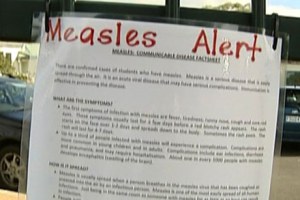It’s been just over a year since a large measles outbreak began in Auckland, New Zealand. The outbreak was originally traced to a young purposely unimmunized traveler returning from the United Kingdom. Unfortunately this case was not diagnosed or notified on suspicion. The case subsequently attended school, which had low immunization coverage, and infected several people sparking an outbreak of well over 500 cases.
At its peak the measles outbreak was causing between 20 and 30 cases per week. For much of 2011 New Zealand had amongst the highest measles incidence in the western Pacific. The outbreak in Auckland officially continues, but public health measures have reduced cases to two or less per week since early March this year.
Dr. Richard Hoskins, a public health medicine specialist with the Auckland Regional Public Health Service, kindly took the time to describe the measures Auckland implemented to slow the outbreak and the challenges and lessons along the way:
 “When Auckland’s measles outbreak began in late May 2011 we immediately commenced usual public health actions to try to minimise further spread. This included isolation of cases that were still infectious; management of the contacts of those cases to determine whether they were likely to already be immune, and if not immune then prophylaxis with immunisation or immunoglobulin if indicated and quarantine (at home) to prevent further spread once they developed measles.
“When Auckland’s measles outbreak began in late May 2011 we immediately commenced usual public health actions to try to minimise further spread. This included isolation of cases that were still infectious; management of the contacts of those cases to determine whether they were likely to already be immune, and if not immune then prophylaxis with immunisation or immunoglobulin if indicated and quarantine (at home) to prevent further spread once they developed measles.
We also ensured wider communications through the affected school, primary care and hospitals on our website and with the media. Our communications concentrated on encouraging people to catch up with any overdue immunisations and, if they thought they might have measles to isolate themselves and seek medical care (but to avoid waiting rooms and other places where they might infect others).
Unfortunately the first case had not been diagnosed, tested, or notified to public health while ill and infectious. They had already infected at least seven people in the school before a case was notified to public health. Many of those seven secondary cases had been infectious for several days before public health was even aware of the outbreak.
The outbreak was already spreading in the community and despite the intensive public health work I’ve described control was not able to be established. As numbers intensified the health sector’s primary emphasis was to improve immunisation uptake and encourage people to ensure they’d had two doses of measles containing vaccine.
We also moved the scheduled measles, mumps and rubella (MMR) doses forward from 15 months to 12 months and from four years to one or more months after the first dose, so primary care sent out reminders and recalled people where information showed they were not up to date with MMR.
The outbreak has placed huge demands on our health system, initially with public health nurses and doctors diverted from their normal activities for long periods of time and with very high after hours workloads, then with significant impact on primary care (both seeing suspect cases and changes to immunisations), emergency departments and hospital wards.
We continued to provide advice about what to do and how to protect others if you might have measles. This link to our website contains the advice we’d given, information about the spread, and a movie file that shows the spread of the outbreak in Auckland.
Our infant immunisation rates are now nearly high enough to prevent future outbreaks, but unfortunately we still have too many people born since 1969 when immunisation for measles began who have not had two doses of measles containing vaccine. So there is still potential for future large ongoing outbreaks like this one.
Lessons
What lessons can Auckland teach other health authorities globally? Public health control of measles can work. In 2011 we had eight separate instances of measles imported from overseas, only two lead to outbreaks of measles, the other six were successfully contained with intensive isolation, contact tracing, and quarantine.
But ultimately communities will remain at risk if measles is circulating anywhere on the globe, and so we must improve on time coverage of a two dose measles immunisation strategy. Even good population immunity levels are no good if there are communities within that population with poor immunisation coverage.”
About Richard Hoskins :
Dr. Richard Hoskins has been vocationally registered as a Public Health Medicine Specialist since 1992. He has worked in public health planning, funding, consulting and as a designated Medical Officer of Health since 2005 and is a founding fellow of the NZ College of Public Health Medicine. He has worked as Medical Officer of Health for Auckland Regional Public Health Services since 2006.




















 Prelude Version 2.3.2
Prelude Version 2.3.2